Keywords
|
| Retail banking, self service technologies (SSTs), Channel choice, Analytical hierarchy process (AHP), |
INTRODUCTION
|
| In the last two decades, service industry has witnessed tremendous changes in the way business is conducted Comparing to the previous era. Convergence of technologies has made the distribution of services more convenient than ever before. Automatic Teller Machines, bill payment kiosks, internet based services and phone based services (both voice and text), automated hotel check out, automated check-in for flights, automated food ordering system in restaurants, vending machines, Interactive voice response systems are examples of technology based service delivery channels. These technology enabled service delivery mediums are known as self service technologies (SSTs). In case of retail banking the customers receive the services through technology enabled mediums such as Automatic Teller Machines (ATM), Internet and Mobile phone. SSTs are defined as technological interfaces that aid users generating service with out direct involvement from the service company employee (Meuter et al., 2000).The banks adoption of this technology enabled mediums swiftly changed the way the consumers received the services. |
| These SSTs provide advantages for service providers and customers alike (Bitner et al., 2002; Meuter et al, 2000; Bitner et al., 2000; Brown, 1997; Dabholkar, 1991, 1996). When customers of retail banking avail the services through these SSTs, they get more benefits in terms of time, cost and energy; the service providers reduce their personnel costs and gain closer access to the customer. Further in order to project them as tech savvy bank and to have a point of parity, almost all the leading nationalized and private banks in India are offering their services through the every available technology enabled mediums. This leads to a situation in which the customer is confronting with myriad of options to avail the banking service. Not all the services offered through one particular SST are being utilized by the customer. The utilization level varies due to various factors. We theorize that customer will evaluate the different SST options for carrying out specific task and finally settles with the option that will best serve the purpose. Since various factors determines the selection of a specific SST for a specific purpose. The objective of this research is to identify the factors influencing usage of SSTs in general and to identify the priority for the different SST channels in a retail banking environment |
CONCEPTUAL BACKGROUND
|
| In response to the increasing role of technology in services researchers have begun to explore customer perceptions and usage of service delivery technologies. The outcome of these research has shown that adoption of technology-enabled services is impacted by number of factors viz., perceived ease of use and perceived usefulness (Davis, 1989), comparative benefits and advantages offered (Davis, 1993; Agarwal and Karahanna, 2000; Meuter et al., 2000, 2003), perceived risk (Walker et al., 2002, 2006; Meuter et al., 2005), locus of control (Oyedele et al., 2007), self efficacy (Dabolkar and Baggozzi., 2002; Badura,1977), technology reliability (Walker et al., 2002), security (Bitner, 2001; Tero pikkarainen et al., 2004), technology readiness (Liljander et al., 2006) and technology anxiety (Meuter et al.,2005; Oyedele et al., 2007). The existing research on customer adoption of SSTs focuses only a specific SST and few specific factors at a point of time. Most of the research available in the retail banking context deals with adoption of internet banking only. When a customer is confronted with more service delivery channels, then choosing among the alternative delivery channels was studied between personal and technology enabled services (Walker et al., 2002; Dabholkar and Bagozzi, 2002) but not amongst SSTs. The role of purpose and system requirements on the choice of SST in a multiple choice environment has not been studied before. |
| The purpose of SST usage can be classified as customer service, transactions and selfhelp (Meuter et al., 2000).In the banking context customer service denotes getting information about the account balance available, getting statement of accounts, ordering for check books, applying for loans etc. Transaction involves making payments through SSTs like paying electricity bills, Telephone bills, booking tickets for travel and entertainments, third party transactions. Self-help includes knowing about the banks activities, location of branches, interest rates, procedures related to availing different services extended by banks etc |
| Perceived risk (PR) is commonly thought of as felt uncertainty regarding possible negative consequences of using a product or service. Perceived risk was defined by Bauer (1960) to have a two-dimensional structure; namely, adverse consequences, and uncertainty It has formally been defined as ‘‘a combination of uncertainty plus seriousness of outcome involved’’ (Bauer, 1967),’Consequence’ is the degree of importance and/or danger of the outcomes derived from any consumer decision; ‘uncertainty’ is the subjective possibility of these outcome. |
| Cunningham (1967) identified two major categories of perceived risk (a) performance and (b) psychosocial. Further he classified the performance component into three types (i) economic, (ii) temporal, (iii) effort; and classified psychosocial into two types—(i) psychological and (ii) social. Cunningham (1967) further typified perceived risk as having six dimensions—(1) performance, (2) financial, (3) opportunity/time, (4) safety, (5) social and (6) psychological loss. |
| Many researchers have used the six basic dimensions in their studies (for example, Cheron and Ritchie, 1982; Mitra, Reiss, and Capella, 1999; Stone and Gronhaug 1993; Kim and Prabhakar 2002, Featherman and Pavlou 2003) Kim and Prabhakar (2002) explained the effect of perceived risk on accepting technology such as Internet banking by demonstrating that the more perceived risk one has, the less likely he will accept new technology. Many researchers evaluated the role of perceived risk on adoption of SSTs in the banking context (for example Lee 2009, Kuisma et al., 2007, Featherman and Pavlou 2003) |
| Whilst risk is present in every choice situation, it would seem self-evident that these risk dimensions will be present in varying proportions depending on the product or service category under consideration. Services are seen to be riskier than goods, particularly in terms of social risk, physical risk and psychological risk (Murray and Schlacrer, 1990). |
| When customers of retail banking avail the services through these SSTs, they get more benefits in terms of time, money, less physical efforts besides 24 7 access to banking (Bitner et al., 2002; Meuter et al, 2000; Bitner et al., 2000; Brown, 1997; Dabholkar, 1991, 1996).Based on the existing literature it can be implied that SST channel choice is influenced by Purpose, Perceived risk, Benefits and Equipments & skill requirement. |
ANALYTICAL HIERARCHY PROCESS METHODOLOGY
|
| The AHP is a mathematical method used to determine the priorities of different decision alternatives via pair wise comparisons of decision elements with respect to a common criterion. It provides an objective way for reaching an optimal decision for both individual and group decision makers. It is the widely adopted method in the cases where the decision of the selection among the given alternatives and their ranking is based on several attributes. The AHP technique is extensively used in modeling the human judgment process (Lee et al 1995). This method is based on the problem decomposition into a hierarchy structure which consists of the elements such as: the goal, the criteria (sub-criteria) and the alternatives. The output of this method is a prioritized ranking, indicating the overall preference for each of the decision alternative.AHP has three major steps (Saaty 1994) |
| (i) Problem decomposition: A complex problem is decomposed into levels consisting of a few manageable elements; each element is also, in turn, decomposed hierarchically in lower decision levels. The hierarchy model of the decision problem is developed in such a way that the goal is positioned at the top, with criteria and sub-criteria on lower levels and finally alternatives at the bottom of the model. |
| (i) Problem decomposition: A complex problem is decomposed into levels consisting of a few manageable elements; each element is also, in turn, decomposed hierarchically in lower decision levels. The hierarchy model of the decision problem is developed in such a way that the goal is positioned at the top, with criteria and sub-criteria on lower levels and finally alternatives at the bottom of the model. |
| (iii)Synthesis of priorities: On the basis of the pair wise comparisons relative significance (weights) of elements of the hierarchy structure (criteria, sub-criteria and alternatives) are calculated, which are eventually synthesized into an overall alternatives priority list. The priority weights of each element will be calculated based on Eigen vector. |
| The computational process of the priorities is detailed in this section. Let there be n criteria and their actual relative priorities are w1, w2 ,…, wn. Further, let A be an n × n matrix of pair wise comparison, whose elements are assigned from Table 1. These elements, aij may be regarded as an estimate of the ratio wi /wj. |
 |
| We suppose that aij > 0 and aij = aji -1.If the relative significance ratios aij are used to form the matrix A, and in the case of consistent evaluations where aij = aik akj the equation Aw = λmaxw is satisfied. The analytical solution of Equation (2) then provides the relative weights for each decision element. According to the eigenvalue method, the normalized right eigenvector (W = {w1, w2 ,…, wn}T) associated with the largest eigenvalue (λmax) of the square matrix A provides the weighting values for all decision elements. The largest eigenvalue (λmax) can be computed by using Equation (3) |
 (2) (2) |
 (3) (3) |
| The weights are normalized by constraint Σwi=1.Due to this matrix features the λmax ≥1 is valid, whereas the difference λmax – n is used for measuring the assessment consistency. By means of consistency indices given by equation (4) |
 (4) (4) |
| The consistency ratio CR=CI/RI can be computed, where RI is the random index (consistency index for matrices with random generated pair wise comparisons). The table 2 with the RI values computed by simulation is used for the calculation of the CR. Generally, a CR of 0.10 or less (for n ≥ãÃâ¬Ãâ¬5); 0.09 or less (for n = 4); 0.05 or less (for n = 3), is considered acceptable. Otherwise the relative importance for each objective will be revised to improve the judgmental consistency. Then the priorities are pulled together through the hierarchic composition to provide the overall assessment of the available alternatives. |
APPLICATION OF THE AHP TECHNIQUE IN CHOICE OF SST
|
| Consumer’s choice criteria for SSTs: Consumers’ choice criteria were determined based on the existing literature (Walker et al., 2002, 2006; Meuter et al., 2005, Davis, 1993; Agarwal and Karahanna, 2000; Meuter et al., 2000, 2003 Lee et al 2009, Kuisma et al., 2007, Featherman and Pavlou 2003).Figure 1 shows the structuring of the hierarchy of consumers’ choice problem, which includes four levels. The top level of the hierarchy represents the ultimate goal of the problem, while the second level of the hierarchy consists of four main channel selection criteria, which are namely Purpose, Perceived risk, Benefits, Requirements. At the third level, these criteria are decomposed into various sub-criteria that may affect the consumer’s choice for a particular channel. Finally, the bottom level of the hierarchy represents the alternative SST channels. Based on the criteria and sub criteria considered, a detailed instrument was developed for capturing the customer preference. |
| Calculation of the weights of the criteria: First the degree of preference between and within the criteria at each level of the hierarchy in a pair wise form using Saaty’s scales ranging from 1 – equally preferred to 9 – extremely preferred. The data was obtained from 40 customers of a reputed, nationalized bank located in the technological university where the author’s are affiliated. Next step involves the weight calculation of each level to obtain the overall score of each SST channel with respect to all 17 sub-criteria and pair wise comparisons of the main selection criteria. Table 2 presents the local weights of each SST channel with respect to main channel selection criteria and the synthesized priority score for each SST channel. The detailed calculation of the local weights using AHP methodology is given in the Appendix-A. |
CONCLUSION AND MANAGERIAL IMPLICATIONS
|
| This study explains the customer preferences towards SST channels in a multi channel environment. The real choice criterion which includes the Purpose, Perceived risk, Benefits and Requirements cannot be quantitatively and precisely measured. The application of AHP which enable to capture decision maker’s subjective evaluation related to channel selection criteria provide accurate and consistent channel preferences. On a whole ATM is found to be the most preferred channel followed by Internet banking and Mobile banking with more or less equal weights. When it comes to catering various purposes for which SSTs are used, the internet banking is widely used for Service requests, availing information and fund transfer followed by mobile banking and ATM as customers use Internet and mobile for service requests and availing information. For avoiding the perceived risk associated with SSTs, ATM is the most preferred channel followed by Internet banking and Mobile banking. The perceived benefits of the all the three SST channels found to be equal though the patronage is not uniform. Under the system and Skill requirements criteria, ATM is mostly preferred as one need not own any equipment and need little skills to use it. Mobile banking is the next preferred channel under these criteria. The customer need to own hand sets with blue tooth facility and software provided by the bank need to be installed in it so as to carry out fund transfer through mobile phones. Internet banking is the least preferred channel under system skill requirement criteria as the customer need a computer with internet connection. As the benefits perceived equal amongst the SST channels, the patronage for Internet banking and mobile banking can be improved if the risk perception is reduced. |
Tables at a glance
|
|
|
| |
Figures at a glance
|
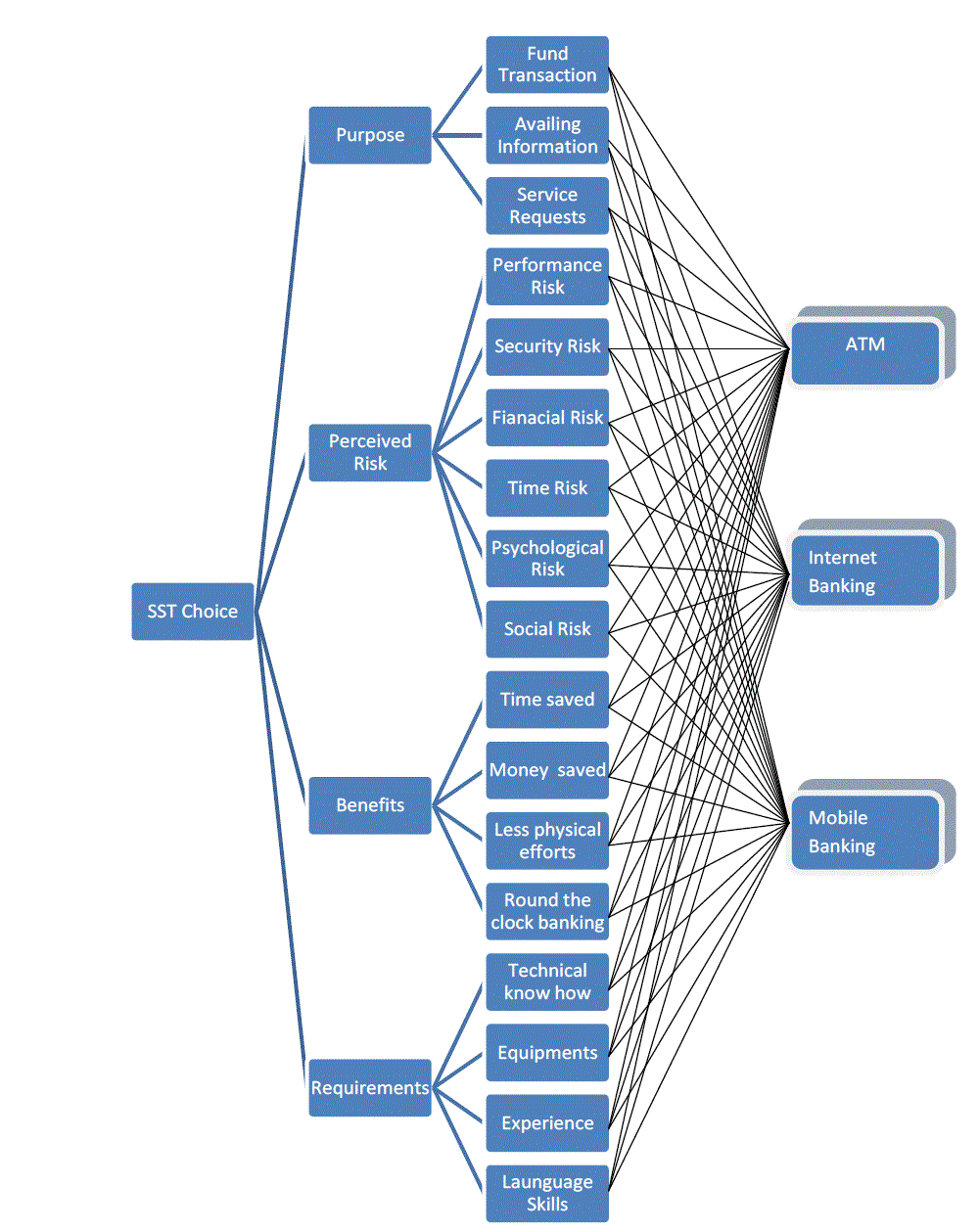 |
| Figure 1 |
|
APPENDIX-A
|
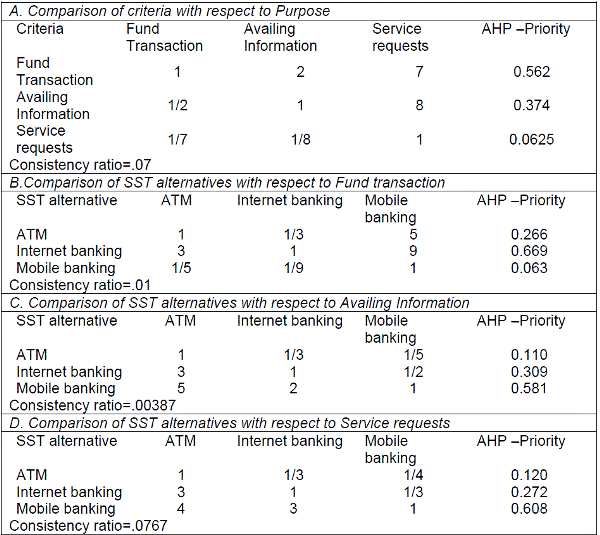 |
Computation of Local weight for ATM, Internet banking, Mobile banking under the criteria purpose is as follows
0.562*0.266+0.374*0.110+.0625*0.120 = 0.198
0.562*0.669+0.374*0.309+.0625*0.272 = 0.508
0.562*0.063+0.374*0.581+.0625*0.608 = 0.291 |
| Table: A1 Local weights for the criteria ‘Purpose’ |
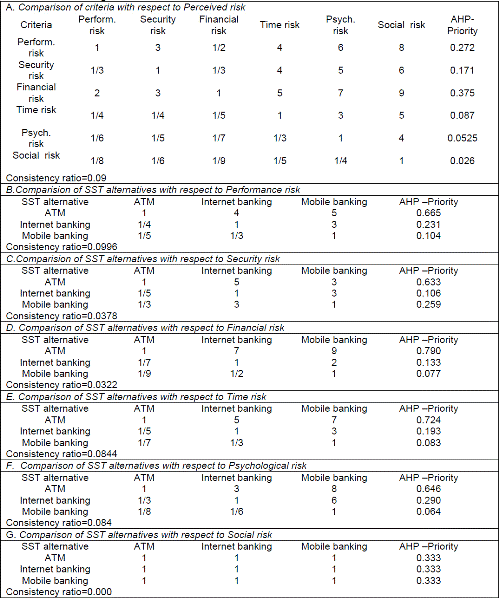 |
| Table: A2 Local weights for the criteria ‘Perceived risk’ |
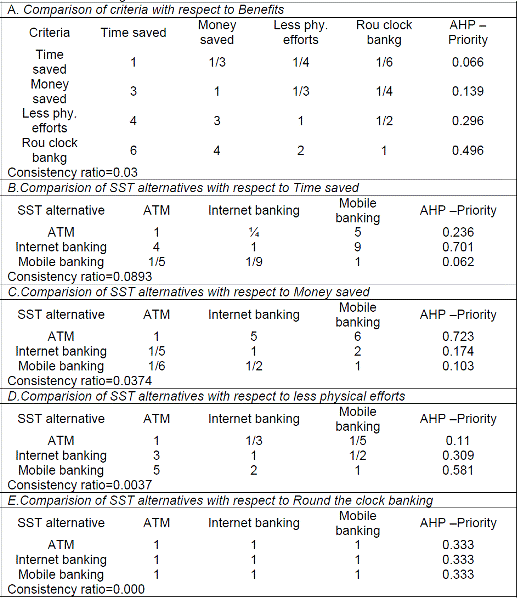 |
| Table: A3 Local weights for the criteria ‘Benefits’ |
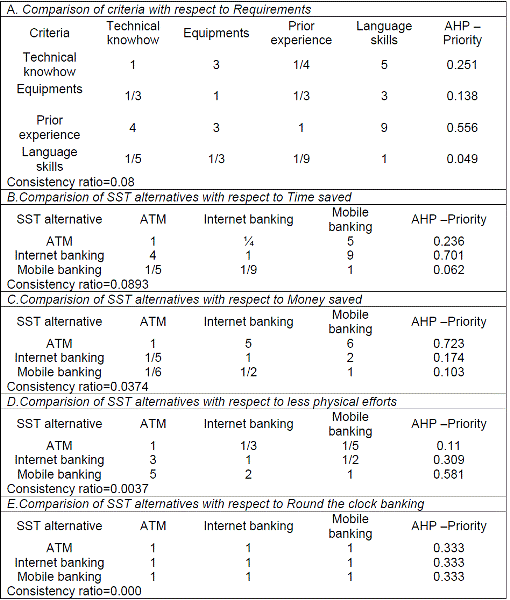 |
| Table: A4 Local weights for the criteria ‘Requirements’ |
References
|
- Agarwal, R. and Karahanna, E. (2000), “Time flies when you’re having fun: cognitive absorption and beliefs about information technology usage”, MIS Quarterly, Vol. 24 No.4, pp. 665-94
- Bandura, Albert. 1977. "Self-Efficacy: Toward a Unifying Theory of Behavioral Change."Psychological Revlew 84:191-215.
- Bauer, R. A. (1960). Consumer behavior as risk taking. in R. S. Hancock (Ed.), Dynamicmarketing for a changing world. (pp. 389-98). Proceedings of the 43rdConference.Chicago, IL: American Marketing Association.
- Bauer, R., (1967). Consumer behavior as risk taking. in: Cox, D. (Ed.), Risk Taking andinformation Handling in Consumer Behavior. Harvard University Press, Cambridge, MA.
- Cheron, E.J. and Ritchie, B.J.R. (1982), “Leisure Activities and Perceived Risk”, Journalof Leisure Research, 14(2), pp. 139-154.
- Bitner, M.J., Brown, S.W. and Meuter, M.L. (2000),“Technology infusion in serviceencounters”, Journal of the Academy of Marketing Science, Vol. 28 No. 1, pp. 138-49.
- Bitner, M.J. (2001), “Self-service technologies: what do customers expect?”, MarketingManagement, Vol. 10 No. 1, pp. 10-11.
- Bitner, M.J., Ostrom, A.L., Meuter, M.L., (2002), Implementing successful self-servicetechnologies. Academy of Management Executive 16 (4), pp 96–109
- Brown S.W (1997), Service recovery through IT, Marketing management, Vol 6, Fall, pp25-37
- Cheron, E.J., & Ritchie, J.R.B. (1982). Leisure activities and perceived risk. Journal ofLeisure Research, 14(2), 139-154.
- Cunningham, S., (1967). The major dimensions of perceived risk. in: D. Cox (Ed.), RiskTaking and Information Handling in Consumer Behavior. Harvard University Press,Cambridge, MA
- Dabholkar, P.A. (1991), “Using technology-based self-service options to improveperceived service quality”, in Gilly, M.C.,Leigh, T.W., Richins, M.L., Venkatesh, A.,Dholakia, R.R., Dwyer, F.R., Dubinsky, A.J., Curry, D., Kotabe, M. and Hills, G.E. (Eds),AMA Summer Educators’ Conference Proceedings, AMA, Chicago, IL, pp. 534-5.
- Dabholkar, Pratibha A (1996) Consumer evaluations of new technology-based selfserviceoptions: An investigation of alternative models of service quality, InternationalJournal of Research in Marketing. Amsterdam: Feb Vol. 13, Iss. 1; pp 29-51
- Dabholkar.P.A,, Bagozzi.R.P (2002), An attitudinal model of technology based selfservice:Moderating effects of consumer traits and situational factors, Journal of theacademy of marketing science, Volume 30,No 3, pp 184-201
- Davis.F.D (1989), Perceived usefulness, perceived ease of use and user acceptance ofinformation technology, MIS Quarterly, September pp 319-340
- Davis, F.D. (1993), “User acceptance of information technology: system characteristics,user perceptions and behavioral impacts”, International Journal of Man-Machine Studies,Vol. 38, pp. 475-87.
- Featherman, M. S., Pavlou, P. A. (2003). Predicting e-services adoption: a perceivedrisk facets perspective. International Journal of Human-Computer Studies 59, 451-474.
- Grewal, D., Gotlieb, J., Marmorstein, H., (1994). The moderating effects of messageframing and source credibility on the price-perceived risk relationship. Journal ofConsumer Research 21,145-153.
- Kim.K and prabhakar B (2002) Initial trust, perceived risk and trusting behavior inInternet banking. Proceeding of the 21 International Conferences on InformationSystems, December Brisbane Australia.
- Kuisma T., Laukkanen T., Hiltunen M. (2007). Mapping the reasons for resistance toInternet banking: A means-end approach, International Journal of InformationManagement 27, 75-85.
- Lee. Heeseok, Kwak, Wikil, and Han,Ingoo (1995), Develping a business performanceevaluation system :an analytic hierarchical model, The Engineering Economist,Vol.40,No.4, pp w343-357
- Lee M. C. (2009). Factors influencing the adoption of internet banking: An integration ofTAM and TPB with perceived risk and perceived benefit, Electronic CommerceResearch and Applications vol 8 pp 130-141
- Liljander veronica, FilippaGillberg, JohanaGummerus,Allard Van Riel (2006),Technology readiness and the evaluation and adoption of self-service technologies,Journal of Retailing and Consumer Services 13 pp 177-191
- Mary Jo Bitner, Amy L Ostrom, Stephen W Brown(2005) Choosing Among AlternativeService Delivery Modes: An Investigation of Customer Trial of Self-ServiceTechnologies. Journal of Marketing, Chicago: Vol. 69, Iss. 2; pg. 61.
- Meuter .M.L, Amy L.Ostrom, Robert I.Roundtree& Mary Jo Bitner(2000), Self serivetechnologies: Understanding customer satisfaction with technology based serviceencounters, Journal of Marketing, vol 64, pp 50-64.
- Meuter, M.L., Ostrom, A.L., Bitner, M.J. and Roundtree, R.I. (2003), “The influence oftechnology anxiety on consumer use and experience with self-service technologies”,Journal of Business Research, Vol. 56 No. 11, pp. 899-906.
- Mitchell, V.W., (1992), Understanding consumers’ behavior: can perceived risk theoryhelp? Management Decision 30 (2), 26–31.
- Mitra, K., Reiss, M.C. and Capella, L.M. (1999), "An Examination of Perceived Risk,Information Search and Behavioral Intentions in Search, Experience and CredenceServices", The Journal of Services Marketing, 13(3), pp. 208-221.
- Murray, K. B. and Schlacrer, J.L. (1990), "The Impact of Services Versus Goods onConsumers' Assessment of Perceived Risk and Variability", Journal of the Academy ofMarketing Science, 18, pp. 51-65.
- OyedeleAdesegun and Penny M. Simpson (2007), An empirical investigation ofconsumer control factors on intention to use selected self-service technologies,International Journal of Service Industry Management Vol. 18 No. 3, pp. 287-306
- Pikkarainen T, Kari Pikkarainen, HeikkiKarjaluoto and SeppoPahnila (2004) Consumeracceptance of online banking: an extension of the technology acceptance model InternetResearch, Volume 14 · Number 3 · pp 224–235
- Saaty, T.L. (1980), The Analytic Hierarchy Process, McGraw-Hill, New York, NY.
- Saaty, T.L. (1994), Fundamentals of Decision Making and Priority Theory with theAnalytic Hierarchy Process, RWS Publications, Pittsburgh, PA.
- Stone, R. N. and Gronhaug, K. (1993), "Perceived Risk: Further Considerations for themarketing Discipline", European Journal of Marketing, 27(3), pp. 39-50.
- Walker, R.H., Craig-Lees, M., Hecker, R. and Francis, H. (2002), “Technology-enabledservice delivery: an investigation of reasons affecting customer adoption and rejection”,International Journal of Service Industry Management, Vol. 13 No. 1, pp. 91-106.
- Walker R.H and Lester W. Johnson, (2006) Why consumers use and do not usetechnology-enabled services, Journal of Services Marketing Volume 20 · Number 2 pp125–135
|